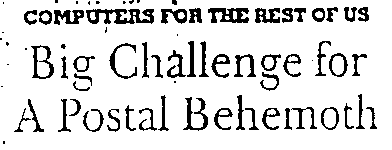

COMPUTERS get hung up on the simplest things. Consider the United States Postal Service. It handles 10 percent of the world's mail - half a billion letters and packages a day. Its $5 billion worth of automated equipment sorts 12 letters a second.
Yet this technological behemoth stumbles badly when confronted by an ordinary handwritten envelope. It can read the address. Despite many advances, handwriting recognition remains one of technology's biggest stumbling blocks.
The postal service is trying to get around the problem by funding research at several institutions, in Europe as well as the US, including the State University of New York at Buffalo. On a recent tour researchers let me test one of their prototype solutions by writing my name and address on an envelope.
Since my handwriting isn't particularly neat (a kind of early Phoenician scrawl), I wondered if the system would blow a fuse. Here is what I wrote:

The system scanned the envelope, ignored the printed return address, and correctly identified my block of writing as the address. It divided the block into lines and words, found the zip code, and correctly deciphered its five digits. It even picked out the street number "40" from the second line of my address.
Pretty good for a machine - but not for the Postal Service which wants a system that can read enough of the address to figure out its nine digit zip code. By 1995, the Postal Service expects to sort 90 percent of machine- printed letters automatically (up from just over 56 percent today) and 50 percent of handwritten letters (up from negligible 4 percent today). The new system will also have to run at the current process time of 12 letters a second.
The is 25 times faster than the best prototype from the Buffalo research center, where researchers are using a technique known as contextual analysis.
People use this all the time without knowing it. For example, my handwritten "Washington" looks suspiciously like "Washinglon" because I didn't cross my "t" very well. Most Americans would read it as "Washington" because they know it's a common name. The computer has to use other clues.
Typically it might read the zip code first and look into its huge 3 billion character database to find that the zip corresponds about Washington, PA. That would allow it to make a quick guess about Washington. By figuring out "40" on the second line, it could narrow its choice of streets to those in Washington that have the number 40. If it figured out that "E" was east, it could further narrow its choices. And so on.
Making all this work coherently will take time. Its potential payoffs are big.
More mail would be automatically sorted (which costs $3 per 1000 letters) rather than mechanically sorted by an operator ($15 per 1000) or by hand ($35 for 1000). Once sorted, all letters would be imprinted with a nine-digit bar code.
The bar codes, in turn, would sort mail according to the carrier's route. Thus, mail carriers could spend two hours a day sorting and six hours delivering - rather than today's average of 4 hours on each task. Estimated savings in processing mail: $230 million to $260 million a year.
--Laurent Belsie